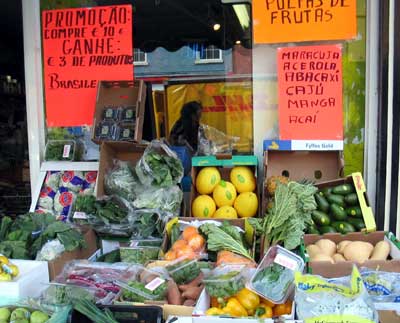|

Sabor Brasil shop on Georges St., Gort
(Claire Healy 2006) |
Gort Inse
Guaire,
or Gort, lies just north of the border with
County
Clare
in south County Galway in the West of Ireland, and has a
population of about three thousand people. It is situated
between the Slieve Aughty mountains and the unique karstic
limestone landscape of the Burren, in the heartland of the
countryside made famous by Lady Augusta Gregory and the poet
W.B. Yeats in nearby Coole Park and Thoor Ballylee.
Nineteenth-century Gort was a thriving market town providing a
commercial centre for its fertile agricultural hinterland. A
market was held in the market square every Saturday, and
sheep, cattle and pig fairs were held regularly. A cavalry
barracks accommodating eight British officers and eighty-eight
soldiers was situated near the town and the
Dublin
and Limerick mail coaches trundled along the main street.
[1] Throughout the nineteenth
century and into the twentieth, day labourers congregated on
the market square in the centre of town hoping for a day’s
seasonal work on a farm.
By the 1990s, the town had become a quiet and sparsely
populated shadow of its former self. Many of the shops along
the main street,
Georges
Street, were shutting their doors for the last time, and the
town was familiar to most Irish people only as a brief stop on
the bus route from
Galway to the southern cities of
Cork and
Limerick. Driving south from the city of Galway to the
approaches to Gort, the bus passes by Labane Graveyard,
fronted by a life-size golden statue of Jesus Christ with his
arms outstretched, reminiscent of the iconic thirty-metre high
statue of Christ the Redeemer on Corcovado Mountain in Rio de
Janeiro, Brazil.
In 1999, a poultry factory in
County
Roscommon applied to the Irish government for work permits and
hired a number of people from Vila Fabril, just outside the
city of
Anápolis in the state of Goiás in
Central
Brazil. Shortly thereafter, Seán Duffy Meat Exports Ltd. in
the outskirts of Gort followed suit and about six people made
the journey from Goiás to
Connacht. The migrant workers to whom the permits were issued were
skilled in meat processing, yet received low wages for their
labours in
Brazil. The
young workers were both male and female, and had worked for a
large factory in Vila Fabril that recently closed down.
|

Bilingual Community Newsletter,
Issue 2 (cover illustration) |
Initially the migrants spoke very little English, but those
who have remained in Gort for the last seven years have become
fluent in the language. The later arrivals still have many
difficulties in communicating with the Gort locals and this
leads to a myriad of problems in relation access to health
services, education and other social facilities. While most of
the Brazilians who have set up families in Gort have married
within their own community, there is a small but growing level
of intermarriage between Brazilian and Irish people in the
town.
Many travelled to Gort intending to stay for a few years,
work hard and earn enough money to return to Goiás to build a
house, start their own business or send their children to
school. Though many came as single people, or left their
spouses and children behind, members of their families have
since joined them in Gort. Those among the community who hail
from urban areas in
Brazil
such as Anápolis and São Paulo value the relative safety that
rural
Ireland
offers for their children. The ensuing seven years have
resulted in a demographic revolution in the small Galway town,
the population of which is currently estimated to be between
25 and 30 per cent Brazilian-born. There are signs that, as is
the case in most migrant communities, some of the Brazilians
in Gort are there to stay.
By Autumn
2004, when Duffy’s was seriously damaged by a fire, at least
fifty Brazilian people were working at the plant. Fortunately
no-one was injured. [2] Still
today a significant proportion of the staff of Duffy’s are
Brazilian and signs in the factory are printed in both English
and Portuguese. Seán Duffy considers them to be reliable,
diligent workers and he provides English classes to his
Portuguese-speaking employees. [3]
A conflagration was again the reason for a tragedy among
Gort’s Brazilian community in early December 2005. Two young
Brazilian men, Roberto Perna Ramos, aged 27, and his uncle
Erli Rodrigues da Silva, aged 43, died in their sleep when the
building in which they were living burnt down. The local Gort
community of Irish and Brazilian people collected enough money
in the wake of the tragedy to repatriate the men’s remains,
and to contribute to the purchase of a house in Brazil for
each of their families. [4]
A large
community of Brazilians now live, work and attend school in
Gort, gradually altering the appearance and the character of
the town. A Pentecostal congregation, the Assembléia de Deus,
has set up a church in the area and the community holds their
own carnaval every Summer. There is also a Brazilian
Catholic community in the town, ministered to by a
Limerick-based priest Fr. Seán Lawler, who says mass in
Portuguese every Sunday in Gort Catholic Church. The local
football team has naturally benefited from Brazilian talent
and experience, while the main thoroughfare now boasts two
Brazilian shops, “Sabor Brasil” on Georges Street and “Real
Brazil” on Crowe Street, where Brazilians and other customers
can purchase Guaraná drinks, palm hearts, Brazilian coffee,
feijão and other necessities. The local fruit and
vegetable shop, “Gort Country Market,” run by Paul Walsh,
stocks a wide variety of reasonably priced Brazilian fruit and
vegetables, such as pinto beans and mandioca (cassava)
and advertises its discount prices in both English and
Portuguese. The shop also imports refrigerated products from
Brazil, via London, including pão de queijo (cheese
bread) and polpas de frutas (fruit pulps). Recently
local chain supermarkets have also begun to stock Brazilian
products.
The occupational distribution of the community has now
diversified, with a number of Brazilians working in the
retail, catering, construction and transport sectors, as well
as in Duffy’s. They currently account for about 40% of the
rental market in Gort. Many are on temporary one-year
employment permits and their continuing right to live and work
in
Ireland is not assured, particularly in view of the large
numbers of Eastern European migrants with unlimited residence
competing for similar jobs.
|

Gort
Country Market, Georges St,
(Claire Healy 2006) |
The combined efforts of the Irish and Brazilian communities
in Gort have resulted in the publication of a bilingual
community newsletter which published its first issue in
February 2006. The newsletter provides advertising, news of
events and general news to the town and surrounding parishes
in English, Portuguese, and often with a smattering of Irish
thrown in. The community has been the subject of documentaries
by the German television station ARD for its Weltspiegel
programme and the Financial Times Deutschland,
and has featured on the Irish station RTÉ’s
programmes Ear to the Ground and No Place Like Home.
The Associação Brasileira de Gort, founded in October 2005,
provides assistance, advice, health promotion and translation
services to the community two days per week in the Family
Resource Centre, and is staffed by seven volunteers - four
Brazilians and three Irish people. [5]
A Brazilian Women’s Group, “Amizade em Ação” (Friendship in
Action) also meets once a week with a programme of talks, art,
aerobics and group dynamics. [6]
The local community school provides both courses in English as
a foreign language for the Brazilian community, and Portuguese
courses for the local community.
Very few
Brazilians intend to remain and settle in Gort, yet one has a
sense that the community is there to stay and many may change
their mind as they build a life for themselves in the small
market town, the population of which is finally beginning to
return to its 1830s levels. At the market square people are
again beginning to congregate in the mornings in the hope of a
day’s work, though they speak in Brazilian Portuguese rather
than in Irish or English. According to journalist Kathy
Sheridan, some Brazilians in Roscommon are now ‘doing what the
Irish emigrants used to do: scouting out jobs for siblings and
in-laws in places such as Athenry, Gort and Roscommon and
advancing their fares if necessary.’
[7] By now some of Gort’s Brazilians have lived and worked
in Ireland long enough to obtain a permanent residence permit
and it is clear that many of them will join the ranks of the
‘New Irish’ of the twenty-first century.
Claire Healy
Notes
[1] Galway Rural Development,
‘Local History, Gort, County
Galway’ on: http://www.gortonline.com/TouristGuide/GortLocalHistory/Gort+Local+History.htm.
[2] Ferrie, Liam (ed.). The
Irish Emigrant Issue No. 922 (Oct 2004).
Available online at:
http://www.emigrant.ie/article.asp?iCategoryID=177&iArticleID=35928
[3] O’Brien, Carl. ‘“All this
will enrich the culture”’ in ‘The New Irish,’ The Irish
Times, 10 May 2004,
p15.
[4] ‘News’ in: Bilingual
Community Newsletter/Jornal Bilingue da Comunidade, Issue
1, February 2006, p4.
[5] ‘The Brazilian Association of
Gort - “Helping Brazilians to help themselves”’ in
Bilingual Community Newsletter/Jornal Bilingue da Comunidade,
Issue 1, February 2006, pp12-13; Vieira, Nilton,
‘Imigração na Europa: Entre a Necessidade e o Medo’ in
Bilingual Community Newsletter/Jornal Bilingue da Comunidade,
Issue 3, April 2006, p5.
[6] ‘Grupo para Mulheres: “Amizade
em Ação” Brazilian Women’s Friendship Group’ in Bilingual
Community Newsletter/Jornal Bilingue da Comunidade, Issue
1, February 2006, p13; Enereh, Monica, ‘Fique por dentro do
que está acontecendo em nossa comunidade!!’ in Bilingual
Community Newsletter/Jornal Bilingue da Comunidade, Issue
2, March 2006, p14.
[7] Sheridan, Kathy. ‘Grateful to
God and Roscommon’ in ‘The New Irish, The Irish Times, 10 May
2004, p15.
References
- Bilingual Community Newsletter / Jornal Bilingue da
Comunidade for Gort and surrounding parishes.
Issues 1 (February 2006), 2 (March 2006) and 3 (April 2006).
- Ferrie, Liam (ed.), The Irish Emigrant,
Issue No. 922 (Oct 2004). Available online (www.emigrant.ie),
accessed 9 April 2006.
- www.gortonline.com, accessed 7 April 2006.
- O’Brien, Carl, ‘“All this will enrich the culture”’ in ‘The
New Irish,’ The Irish Times, 10 May 2004,
p15.
- Sheridan, Kathy, ‘Grateful to God and Roscommon’ in ‘The
New Irish,’ The Irish Times, 10 May 2004,
p15. |




